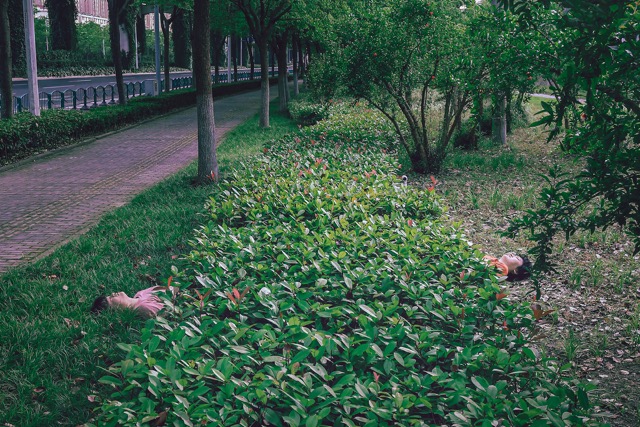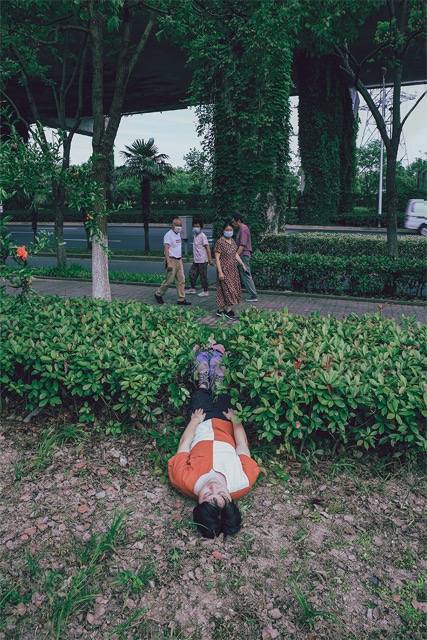Daoyang Han, Peng Ding, and Huadong Zhu: three architects use their bodies to perform order disturbance juxtapositioning urban surroundings and green elements
Break. Control, interrupted
In the Sixties the Situationist International movement took the scene. Born in Como, Italy, the anti-art form consisted of situations created to break the mundane action and events timeline, disrupting the perception of time and its relationship with the environment. Situationism would be distinct from performative art, whose attempt was to leave an imprint, an emotion. It would involve attentive activities shading light on unitary urbanism and psychogeography.
The interest in the psychological intertwinement with geography, experiencing the city, and the marginalized elements of the urban environment united artists and intellectuals of the time. Drawing attention to space became a protest form against mediatic overrule in an era when art was shifting towards pop culture and the fascination with screens inhabiting fame and desire.
The Break performance created by Daoyang Han, Peng Ding, and Huadong Zhu recalls the same urge to acknowledge surroundings and interact with them. It neglects the tendency to alienate from tridimensional surfaces. Screens became the principal space of our existence, subconsciously distancing us from nature-generated landscapes. Guided by the inner instinct to interconnect with the shapes and objects, Peng Ding explains how the idea followed the childhood memories thread.
«As a child, I always imagined myself lying on top of thousands of golden flowers, facing the sky, and feeling the beauty of nature whenever I saw a large field of rapeseed flowers in the countryside. Years later, my childhood urge popped up when I saw the manicured hedges in the city, despite being vastly from the countryside. So one quiet night, I tried to lie down on the hedge, but I sank into it, wrapped in leaves, and when I looked up at the night sky, I felt that the whole world belonged to me at that moment».
Humans as the external force
However, laying on a hedge implies breaking its form by drawing inside the square-fabricated shape. Hedges are a part of nature’s wilderness, domesticated by humans to fit the built-up cities. «Humans as the external force, interrupt the regular green belt, adding disorder, savagery, wildness. It reflects the desire for natural growth as if it was expressing the potential consciousness of breaking the order at the subjective level», writes Han confirming how the hedges have been restored after the shooting.
Daoyang Han, Peng Ding, and Huadong Zhu are three landscape architects who met in Shanghai, the place where they staged the street performance. With a background in architecture and urbanism but also painting and sculpture, the three young creatives sought the opportunity to express the need for discovery even in the closest and most familiar sceneries.
The Break project materialized after the look-down period when people regained control over the outside spaces, recognizing new aspects of city life. «We made the project just after we locked down for three months in Shanghai. I think that triggered it. To me, it means something that’s breaking the order and regular life».
Immortalizing bodies in nature
Changing and domesticating wilderness to make it more attuned to the human habitat is still a form of breaking nature. Adapting and morphing the leaves’ form simultaneously means creating order and disorder within the authentic shape of the green urban tissue. The action remains a form of placing human needs before the instinct of other species. The body of hedges is subordinate to that of people inhabiting cities.
How can we recognize that urban nature has the same power and autonomy as wilderness?
The three landscape architects researched photographs that could reflect their concept, finding images of people laying on lawns or gardens in spaces filled with green elements. If you want to have the same moment of connection with nature, craving to drown in the grass while in the city, why can’t you do it?
The concrete seems to be more fitting for the fabricated life elements like transportation means rather than people. «Hedges are quite different from other wild elements. They are trained to grow up orderly», the flatness of the square form closely reminiscing the comfort and coziness of a bed, contributing to the choice of the hedge.
Capture a few passers-by stopping to understand the Brake performance
People passing by saw the young bodies disrupting the green elements and ruining their structure. They had contrasting reactions. «An old man passing by just shouted to us: what are you doing? How can you do that to the hedges?» recalls Ding, noticing how people saw it as the young generation’s way to tirelessly beg for attention.
The photo of Peng Ding (Chaosteria), and Huadong Zhu lying together capture a few passers-by stopping to understand the Brake performance. «An old lady asked us what we were doing. We said we were doing performance art, and she made a thumbs-up gesture which means encouragement in China».
Opposite responses suggest the impact of performances, which can’t remain a neutral experience for the viewer. You can either enjoy it to the bones, compelled by the message and body manifestation, or refuse its form to break the barriers of linear behavior. While contemplating the project’s future, the three young architects agree it can be repurposed in different cities, where the urban scene and cultural fabric command new performances.
«Repeating it for us would be a boring initiative. We want to explore something new». Growing up in the same countries but different cities and having experience studying abroad – Peng Ding studied in Milan, Daoyang Han in London, and Huadong Zhu in the Netherlands – they share a common background.
«This is why we can do this project together and at the same time have a different explanation about it. If we put it in another city, we would have a different understanding of the cultural contexts. This project’s topic of breaking the order or connecting with nature could also extend to other areas. Maybe we could do a break 2.0 and instead of hedges use water for example».
Brake – Between dreamed-up realities and genuine environments
In their public performance ‘Brake’, Daoyang Han, Peng Ding, and Huadong Zhu used only the human body, emphasizing how it is enough to disrupt nature without involving a technological tool. Breaking means a rupture, falling apart, or a separation caused by an impact. So what shock broke people from their natural habitats?
Screens have become our landscapes, while the fabric of the city inclines toward forbidding color from our surroundings. The perception of space is bent by a constant thirst for entertainment that can come in the form of a movie, a video game, and most recently, the Metaverse.
Everything shifted its focal point on how to move from our world, detached whereas the Break performance it’s so much about going right back to the immediate proximity and connecting to what we have around us.
Studying landscape architecture through Brake
The Brake work itself is about how the body catches the hedge. «It’s a break from daily life, jumping out of life. People could think about it as work on themselves». Huadong Zhu sees it as a means to discovering and researching life around oneself and then imagining it in the future manifesting change and cultural shifts.
By studying landscape architecture, Daoyang Han, Peng Ding, and Huadong Zhu impact the relationship between people and the environment. The way people design their homes and outer areas involves emotion and self-knowledge.
«It’s a way to help people make a connection between the body and the real space, the real world. Nowadays, many people are talking about Metaverse but I believe that before that, we can think more about the real, what we have, and how to make a connection with the land and the people around us. Studying landscapes is a meaningful way of helping people do that».
With the complexity of human nature, we can’t always expect the attachment to surroundings to come naturally but «sometimes it’s super simple – you just lie down. Sometimes you just walk into the forest, just touch the water. We don’t need complex technology to help us reconnect with nature. Maybe we can go back. It’s easy, simple, and direct».
Daoyang Han, Peng Ding, and Huadong Zhu
These three landscape architecture students from China are developing divergent projects in the art bubble, navigating photography, video-making, research, and public performances, such us Brake.




















